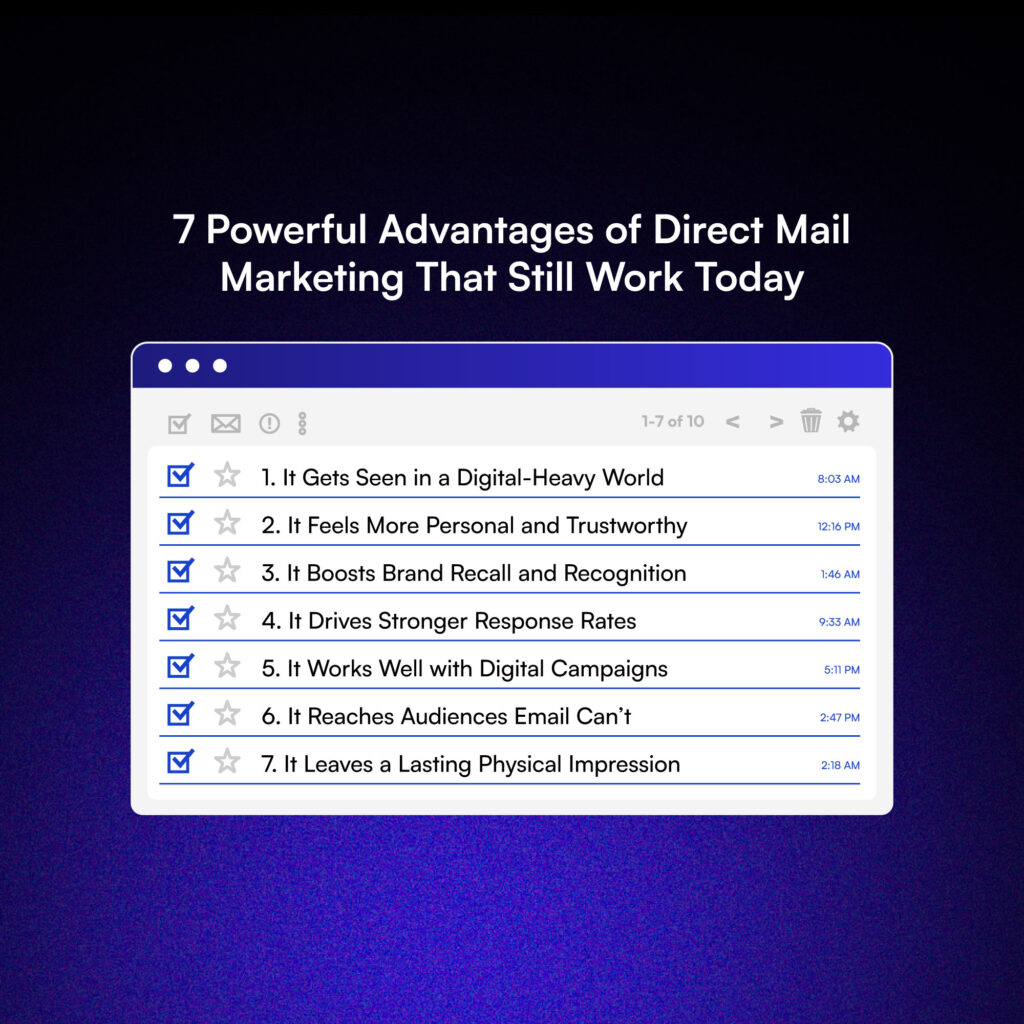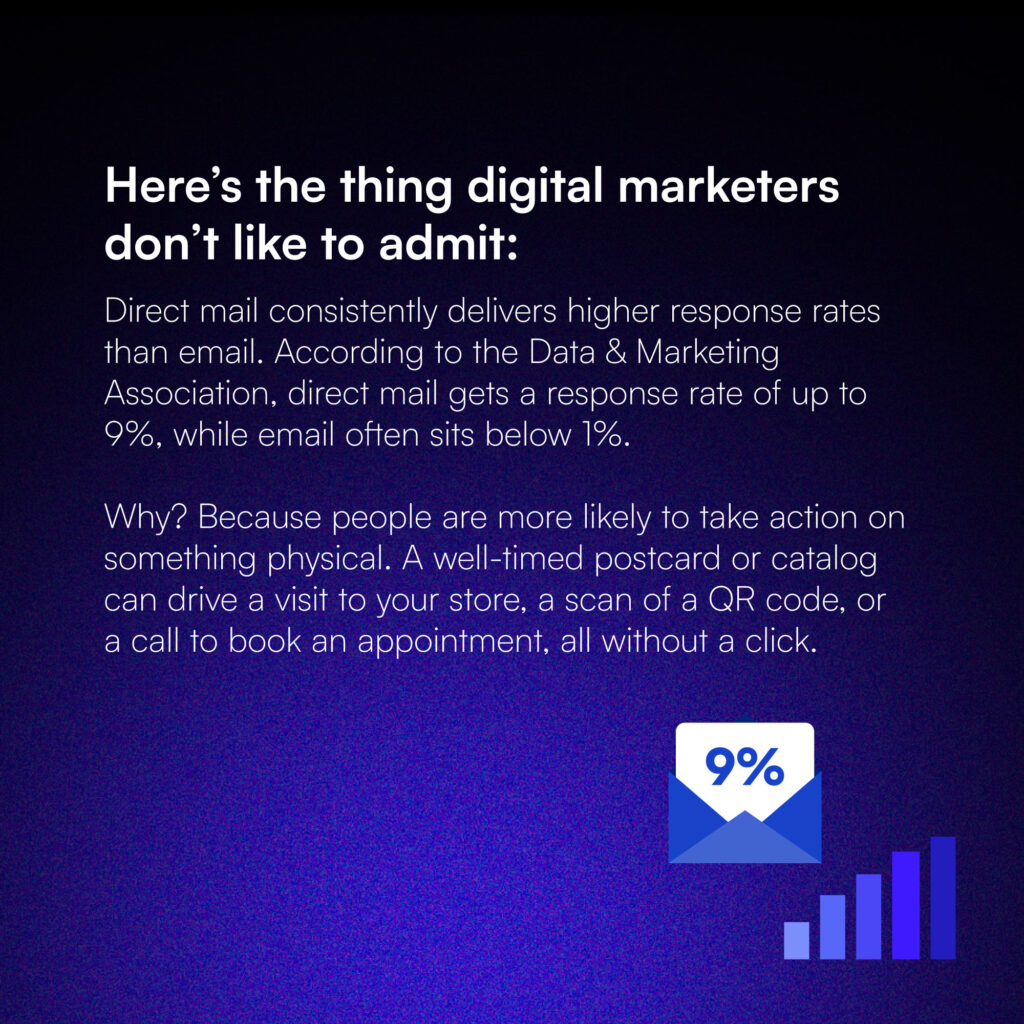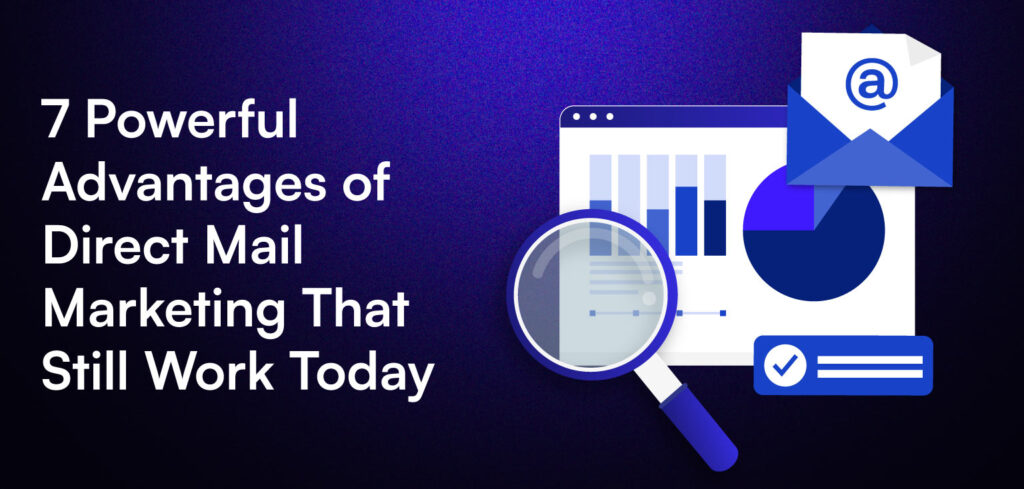Let’s be real, direct mail doesn’t exactly scream “cutting edge.” In a world obsessed with digital, it’s easy to assume print is past its prime. But the truth? Direct mail is having a quiet resurgence, and for good reason.
While inboxes get cluttered with promotions and spam filters block your best work, direct mail lands directly in your customer’s hands, physical, personal, and hard to ignore.
And unlike a display ad that disappears in a second, a well-designed mailer sticks around on desks, fridges, and coffee tables. So, no, direct mail isn’t dead. It might just be your most underrated marketing channel right now.
Here are powerful advantages of direct mail marketing that still work today and how you can use them to cut through the noise and drive real-world results.

1. It Gets Seen in a Digital-Heavy World
While emails pile up in crowded inboxes and ads get skipped or blocked, direct mail shows up without competing for clicks. It’s physical, it’s visible, and it doesn’t disappear with a swipe. There’s simply less noise in the mailbox.
One of the standout advantages of direct mail marketing is the time your message stays in view. A thoughtfully crafted mailer can linger on a coffee table or fridge for days, something most digital content can’t pull off.
Direct mail is one of the few channels left where your message isn’t fighting a hundred others for space. That advantage alone gives it a huge visibility edge.
Pro tip: Use bold design, thick paper stock, or an unusual format to make your mail stand out even more.
2. It Feels More Personal and Trustworthy
Another key advantages of direct mail marketing is how personal and intentional it feels compared to digital noise. In an age where people are skeptical online, physical mail still carries a sense of legitimacy. It feels intentional, considered, and direct. When done right, it feels like it was meant for the person holding it.
Direct mail doesn’t just say, “Hey, look at this offer.” It says, “We thought of you specifically.” And that’s powerful in an age of mass digital communication. Printed materials also feel more official, especially for local businesses, financial services, healthcare, and nonprofits.
The tactile experience makes people slow down and trust more.
Pro tip: Personalize your mail with names, location-based references, or handwritten-style notes to deepen that sense of connection.
3. It Boosts Brand Recall and Recognition
We remember what we touch. That’s the science behind tactile marketing and why direct mail leaves a longer-lasting impression than digital ads ever could. Unlike emails or social posts that flash by in seconds, one of the advantages of direct mail marketing is that it sticks around.
The weight, texture, and even smell of print materials engage multiple senses. That sensory input helps reinforce your brand identity in a way that screens can’t replicate.
Think about it: a postcard with your logo and color palette can sit on a desk for weeks. That repetition without needing multiple ad impressions does wonders for recall. Printed mail also removes distractions.
When someone holds your piece, there are no pop-ups, sidebars, or push notifications to compete with. That focused attention is a rare and valuable thing.
Pro tip: Use consistent brand elements like fonts, color schemes, and logos to reinforce recognition across both print and digital.
4. It Drives Stronger Response Rates

Here’s the thing digital marketers don’t like to admit: Direct mail consistently delivers higher response rates than email. According to the Data & Marketing Association, direct mail gets a response rate of up to 9%, while email often sits below 1%.
One of the major advantages of direct mail marketing is its ability to drive real action. People are more likely to respond to something they can hold. A timely postcard or catalog can prompt a store visit, a QR code scan, or even a direct call, no clicks required.
Direct mail also cuts through fatigue. With inboxes overflowing and banner blindness at an all-time high, your audience may simply tune out digital. Mail gives them a break from the screen and a reason to engage.
Pro tip: Always include a strong call-to-action and a unique code or URL so you can track what worked.
5. It Works Well with Digital Campaigns
Direct mail is a powerful teammate for your digital efforts. The best marketers know how to use both together. A mailer can drive people to a landing page with a personalized URL.
It can include a QR code that opens a video, offer, or instant sign-up form. These small touches turn paper into a clickable, trackable experience. You can also sync mail drops with your email campaigns or ads.
That way, people are seeing your message across channels, which increases trust and recall. It’s not about choosing print or digital, it’s about combining them for a bigger impact.
Pro tip: To make the most of these advantages of direct mail marketing, use tools like UTM codes and dynamic QR codes to track conversions and see how direct mail supports your overall funnel.
6. It Reaches Audiences' Email Can’t
Not everyone lives in their inbox. Some people rarely open marketing emails others may not even have consistent access to digital platforms. That’s where one of the key advantages of direct mail marketing shines: its ability to reach audiences beyond the screen.
It gives you a reliable way to reach demographics that are either offline, screen-fatigued, or just plain immune to digital advertising. Whether it’s older customers, rural communities, or those who prefer tangible experiences, direct mail bridges the gap.
Plus, email inboxes have filters. Spam folders don’t exist in mailboxes. When you send something physical, you’re almost guaranteed to land in someone’s hands, not their junk folder.
Pro tip: Use direct mail to complement email gaps in your list. If you have inactive subscribers, a well-timed postcard could be what re-engages them.
7. It Leaves a Lasting Physical Impression
In a digital world, print feels premium. A high-quality mailer says, “We care about this message.” It instantly positions your brand as thoughtful, polished, and credible.
The weight of a well-printed catalog or the feel of embossed lettering does more than look good, it builds brand equity. You’re not just sending an ad; you’re delivering an experience.
That tactile element makes your business memorable long after the message is read. Unlike a pop-up or banner ad that vanishes in seconds, one of the advantages of direct mail marketing is that it has staying power. People pin it to corkboards, stick it on fridges, or leave it on their desks.
That kind of visibility can’t be bought with pixels.
Pro tip: Invest in good paper stock and professional design. Small upgrades make a big impression.
So, What Now?
Direct mail marketing isn’t outdated; in fact, it’s underrated. One of the biggest advantages of direct mail marketing is its ability to cut through the digital clutter. While everyone else is fighting for attention in crowded inboxes and over-saturated feeds, direct mail slips past the noise and delivers real, tangible results.
From higher response rates to better brand recall, it does what digital marketing can’t always do: get seen, get remembered, and drive meaningful action. When used strategically and especially when paired with digital, it becomes a powerful piece of your marketing toolkit.
So, if you’ve been overlooking direct mail, now’s the time to rethink. The mailbox might just be your brand’s next big opportunity.


